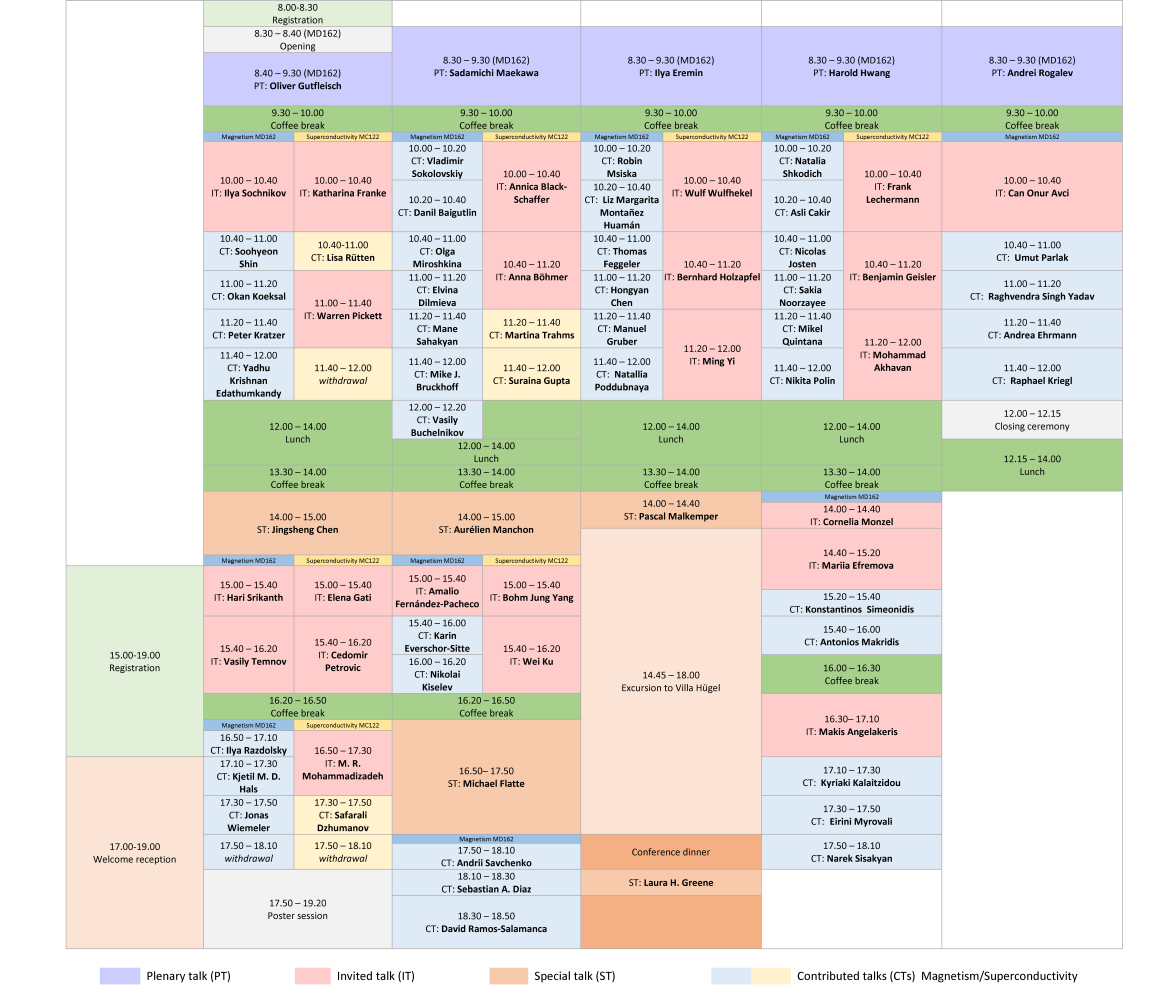Conference topics
Magnetism
- Hard magnetic materials
- Magnetocalorics
- Magnetization dynamics
- Nanoscale magnetism
- Magnetic materials in biology and medicine
- Novel magnetic materials and emerging phenomena
- Multifunctional magnetic materials
- Frustration and topology in magnetism
- Unconventional processing for magnetic hysteresis design
- Experimental methods
Superconductivity
- High-Tc superconductivity
- High pressure hydrides
- 2D superconductors
- Magnetic superconductors
- Topological superconductors
- Heavy fermions
- Superconductivity in confined geometries
- Tunneling and Josephson junctions
- Emerging superconducting materials
- Superconducting devices
|
Plenary and Invited Speakers
- Mohammad AKHAVAN, Sharif University of Technology, Iran
- Oxygen and rare earth doping effects on RE3Ba5Cu8O19-δ (RE=Y, Sm) superconductors
- Makis ANGELAKERIS, Aristotle University of Thessaloniki, Greece
- Magnetically driven therapies: Toxicity, Risks and Side-effects
- Can Onur AVCI, Institut de Ciencia de Materials de Barcelona (ICMAB-CSIC), Spain
- Chiral interlayer coupling in magnetic multilayers
- Annica BLACK-SCHAFFER, Uppsala University, Sweden
- Nematic d-wave superconductivity in magic-angle twisted bilayer graphene from atomistic modeling
- Anna BÖHMER, Ruhr University Bochum, Germany
- Nematicity in unusual iron-based superconductors
- Jingsheng CHEN, National University of Singapore (IEEE Magnetics Distinguished Lecturer 2022)
- Symmetry breaking by materials engineering for spin-orbit-torque technology
- Mariia EFREMOVA, Eindhoven University of Technology, The Netherlands
- Iron-biomineralizing encapsulin proteins as a new tool for non-invasive tracking and manipulation of mammalian cells
- Ilya EREMIN, Ruhr University Bochum, Germany
- Magnetic skyrmionic textures in proximity to a superconductor: vortex-skyrmion interaction, Meissner currents, and charge/spin supercurrents
- Amalio FERNÁNDEZ-PACHECO, CSIC-University of Zaragoza, Spain
- Geometrical effects in three-dimensional magnetic and superconductor circuits
- Michael E. FLATTE, University of Iowa, US (IEEE Magnetics Distinguished Lecturer 2022)
- Coherent magnonics for quantum information science
- Katharina FRANKE, Free University Berlin, Germany
- Quantum spins and hybridization in artificially-constructed chains of magnetic adatoms on superconducting 2H-NbSe2
- Elena GATI, MPI CPfS Dresden, Germany
- - Effect of uniaxial and hydrostatic pressure on competing phases in iron-based superconductors
- Benjamin GEISLER, University of Duisburg-Essen, Germany
- Role of the film geometry in the electronic reconstruction of infinite-layer nickelates on SrTiO3(001)
- Laura H. GREENE, National MagLab / Florida State University
Physics, US
- The changing landscape of science diplomacy
- Oliver GUTFLEISCH, TU Darmstadt, Germany
- Advanced magnetic materials for efficient energy, transport and cooling applications
- Bernhard HOLZAPFEL, Karlsruhe Institute of Technology, Germany
- - Tailored High Tc Superconductors for Power and Magnet Applications
- Harold HWANG, Stanford University, US
- Superconductivity in infinite-layer nickelates
- Wei KU, Tsung-Dao Lee Institute, Shanghai Jiao Tong University (to be confirmed)
- Superfluid and non-superfluid properties of emergent Bose liquid: Exotic transport and optical properties resembling unconventional superconductors
- Frank LECHERMANN, Ruhr University Bochum, Germany
- Multiorbital perspective on correlated electrons in superconducting nickelates
- Sadamichi MAEKAWA, RIKEN Center for Emergent Matter Science, Japan
- Spin Current in Superconductor/Ferromagnet Heterostructures
- Erich Pascal MALKEMPER, Max Planck Institute for Neurobiology of Behavior - caesar, Germany
- Navigating in the dark - studying the magnetic sense of mole-rats
- Aurélien MANCHON, Aix-Marseille University, France (IEEE Magnetics Distinguished Lecturer 2022)
- Exploring the potentials of spin-orbitronics
- Mohammad Reza MOHAMMADIZADEH, University of Tehran, Iran
- Hydrogen in metal/metal oxide hydrides
- Cornelia MONZEL, Heinrich-Heine University Düsseldorf, Germany
- Semisynthetic Magnetic Nanoparticles for Remote Actuation of Biological Processes
- Cedomir PETROVIC, Brookhaven National Laboratory
- Disorder in FeSe1−xSx (0 ≤ x ≤ 1) superconducting crystals
- Warren PICKETT, University of California Davis, US
- Non-symmorphic band sticking in a topological superconductor
- Andrei ROGALEV, ESRF, France
- Hard X-ray Magnetic Circular Dichroism: Where from? Where to?
- Ilya SOCHNIKOV, University of Connecticut, US
- Tunable magnetic domains and walls in a noncentrosymmetric ferromagnetic Weyl semimetal
- Hari SRIKANTH, University of South Florida, US
- Thermally induced spin transport and magnon propagation length in garnet heterostructures
- Vasily TEMNOV, LSI, Ecole Polytechnique, CEA/DRF/IRAMIS, CNRS, IP Paris, France
- Recent progress in ultrafast magneto-acoustics
- Wulf WULFHEKEL, Karlsruhe Institute of Technology, Germany
- Is lead really a prototypical type I superconductor? New results on the phase diagram at ultra-low temperatures
- Bohm Jung YANG, Seoul National University, South Korea
- Correlated normal state fermiology and topological superconductivity in UTe2
- Ming YI, Rice University, US
- Emergent phases in geometrically-frustrated lattices
|


